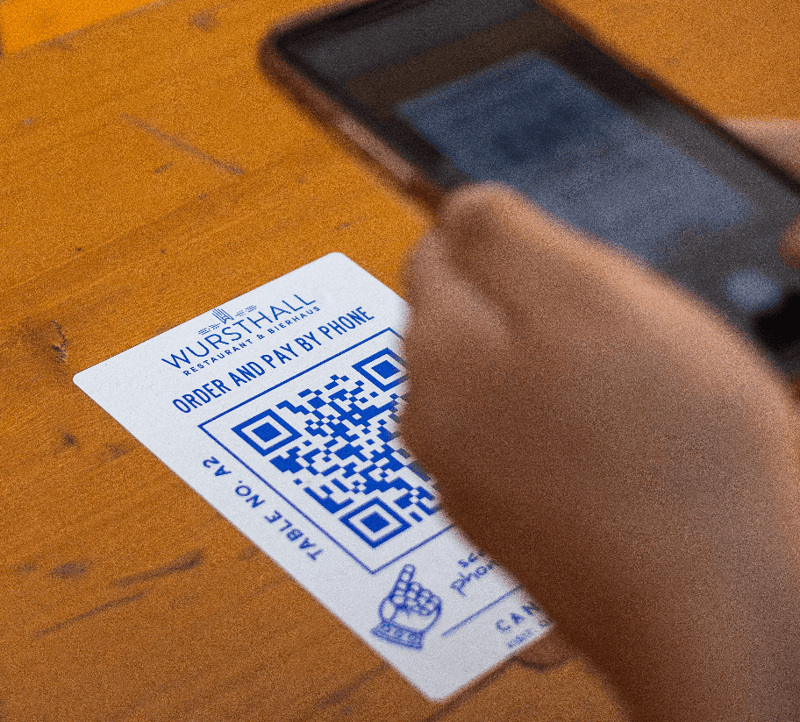QR Code Menus: Should Your Restaurant Have One?
According to a study conducted by Good Morning America, physical restaurant menus are the most contaminated items on a restaurant table.
These menus could pass through thousands of hands each month and they may not be regularly cleaned.
With restaurants quickly moving towards more automation of various operations, now is the perfect time for your restaurant to replace those high-touch paper or plastic menus with QR code menus.
Besides the hygiene aspect, a QR code menu can provide numerous other benefits to your customers and benefits to your restaurant.
What is a QR code?
A QR, or “quick response,” code is a unique square pattern made of smaller squares within it. Its primary purpose is to provide you with information when you scan it.
It is similar to the barcode you see on your clothes or on the back of your grocery items. For traditional barcodes, the information is encoded depending on the breadth and distance between each bar, and a special barcode scanner is required to read the information. While on the other hand, with QR codes, the QR code scanner is any smartphone.

Most smartphones can scan QR codes, simply by using the camera app.
This widespread accessibility has made the rapid adoption of QR codes possible, especially in the hospitality industry. QR codes are called “quick response,” as they provide information immediately.
Menus with QR codes
Incorporating QR technology in your restaurants will digitize your entire menu.
Your guests can use their phone’s camera to scan your QR code. This will lead them to your digital menu where they can browse your restaurant’s offerings. This entire experience only involves the customer touching their own smartphone, which helps with hygiene.
Depending on your restaurant’s requirements, you can add various additional features to your digital menu. For example, some restaurants only allow diners to browse through the menu, while others also allow them to order food directly.
Additional features include paying the bill online or enabling customers to pre-order their meal before arriving. Which ever route you take, a QR code menu can help your business.
How to implement a QR code menu
Implementing QR menus in your establishment can be quick and easy. There are various paid and free QR code generator creating tools available online, like the Google QR code generator.
First you must create a digital menu, either in a PDF or jpeg format. Then upload your menu (either to your website or to an online drive like Dropbox or Google Drive). At this point you can generate your QR code, which will link people to your digital menu when they scan the code.
Make sure you test it before you start to display the menu in your restaurants. It’s crucial to make the digital menu user-friendly and well-designed so it is easy to read on a smartphone.
Placing the QR code menu
Once you have generated your menu's unique QR code, you can print it and choose how and where to display it in your restaurant. The most common method is to display them as table tents on each table. You can print a QR code on both sides of the tent, allowing users on either side of the table to scan it quickly.
Many restaurants also display their QR codes at their entrance. This enables walk-in customers to quickly scan and browse your menu before entering. This may lead to increased footfall in your restaurant and will work well if it is located in a mall or a pedestrian-friendly street.
Other creative ways of displaying your QR codes are on your take-out bags and business cards. Again, this method acts as a quick and convenient way of marketing as it increases awareness of your restaurant.
Dynamic QR codes
There are two types of QR code technologies that you can use to create your menu - static and dynamic. The most significant advantage of using a dynamic QR code is that its flexibility allows you to continually edit the digital contents of your menu without having to create a new QR code all over again.
Unlike static QR codes, dynamic QR codes can be updated all in one go, saving a lot of time and effort. They also scan faster as they have shorter URLs, and their pattern is less dense, which improves your customer’s experience.
Lastly, dynamic QR codes can track critical data such as the number of scans you get, the location and time at which people scanned your QR code, and which dish is the most popular. Insights from this data can help you streamline your business processes and increase long-term efficiency and profits.
Benefits of QR code menus
Safety
Even after COVID, people will continue being averse to touching anything frequently used by many others - such as cash and menus. A QR code menu solves this problem by making ordering contactless.
Frees up resources
If most of the menu browsing and ordering happens online, your on-the-ground staff will be more free. You will be able to divert their time and energy towards other things your restaurant may need - cleaning, kitchen help, delivery, and more. You could also reduce the number of staff working in your restaurant to improve your profit margins.
Saves on printing costs
In the case of physical menus, you have to reprint all of them each time you make a change. This can be both a costly and time-consuming affair. However, if you’re using QR code menus, especially dynamic QR codes, you can update your menu and add/delete new items as many times as you need to.
If a particular dish goes out of stock and can no longer be served, you can simply update this information in your online menu. You can either disable the dish from being ordered or merely put a disclaimer stating that the dish is out of stock. Hence, you can keep updating your menu in real-time, improving your customers’ dining experience.
Interactive menu options
By optimizing your menu design and format and including pictures or videos of the dishes you serve, you can substantially improve the user experience. This works exceptionally well if your cuisine is exotic, experimental, or uncommon. An interactive menu could result in a higher number of orders while also allowing you to nudge customers into ordering certain dishes.
Best Practices
Inform your customers
Due to the widespread use of QR codes, most people now know how to use them. But to create a more personalized experience for your customers, it is always good practice to mention simple instructions such as, “open your camera,” “scan the code,” and “enjoy your food!”
Train your staff
While your staff may not need to take orders now, keeping them updated about the menu is wise. Again, if you have an exotic or uncommon menu, your guests may prefer to get personalized and direct advice from your servers regarding the items or dish pairings. Additionally, ensure that your staff knows how to use and troubleshoot QR code technology in case of inexperienced customers.
At the end of the day, no matter how much technology advances, you have to decide the vibe of your restaurant. Depending on the vision, brand, and concept you have in mind, you can choose the extent to which you want to incorporate the QR code tech. For example, maybe your digital menu is only for viewing and browsing purposes, while the order is placed through a server to create a more comfortable experience. Conversely, you can automate the entire process from ordering to paying.
Either way, we can help you out with payment processing. At Paystone, we offer physical and virtual terminals for those of you who wish to keep a manual aspect of payments in place. For others, we offer an end-to-end payment integration, allowing you to accept payments via your website.

